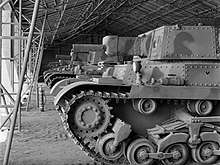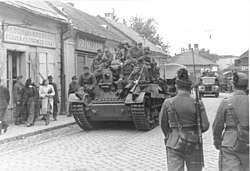40M Turán
The Turán was a Hungarian medium tank of World War II. Based on the design of the Czechoslovak Škoda T-21 medium tank prototype, it was produced in two main variants: the 40M Turán (or Turán I) with a 40 mm gun and the 41M Turán (or Turán II) with a 75 mm gun. A total of 424 were made.
| 40M/41M Turán | |
|---|---|
 40M Turán in 1943 | |
| Type | Medium tank |
| Place of origin | Kingdom of Hungary |
| Service history | |
| Wars | World War II |
| Production history | |
| Designer | Škoda Works,Institute of Military Technology of the Hungarian Army (HTI),DIMÁVAG factory[1] |
| Designed | 1938 |
| Produced | 1940–1944 |
| No. built | 424 |
| Variants | 40M Turán 41M Turán 43.M Turán |
| Specifications | |
| Mass | 18.2 tonnes |
| Length | 5.55 m |
| Width | 2.44 m |
| Height | 2.39 m |
| Crew | 5 |
| Armor | max. 50 mm |
Main armament | 40 mm 41M L/51 (40M Turán) 75 mm 41M L/31 (41M Turán) |
Secondary armament | 2× 8 mm Gebauer 34/40.M machine guns |
| Engine | gasoline Weiss Manfréd Z-V8H-4 260 hp (195 kW) |
| Power/weight | 14 hp/tonne |
| Suspension | leaf-spring bogie |
Operational range | 165 km |
| Maximum speed | 47 km/h |
A prototype variant, the 43M Turán (or Turán III) was also turned out but did not go into production.
History
In December 1937 the Škoda workshops prepared a prototype of a medium tank based on the earlier successful LT vz. 35 project. Two prototypes were started and designated S-IIc, but their construction was never finished. The tank weighed 16.5 tonnes (16.2 long tons; 18.2 short tons), was armed with a 47 mm Škoda A9 vz. 38 gun, two 7.92 mm machine guns and its maximum armour was extended to 30 mm. Finally, the S-II-c was to have a better 13.8 liters engine giving 250 hp; this increased the maximum speed to roughly 50 km/h.
After Germany annexed Czechoslovakia, the prototypes were finished under the new designation of T-21, which in turn was a predecessor of a new prototype; the T-22. Two of the latter type were given to Hungary in 1941. The Hungarian engineers decided to replace the original 47mm gun to a Hungarian produced 40mm gun for both economic and military reasons. Military experts stated that the armor penetration of the 47mm gun was not better than the homemade 40mm's because the later one had a much higher muzzle velocity. The modifications of the tank gun were carried out by the Škoda factory - they used the original Czech gun cradle and placed a Hungarian made barrel in it. The frontal armor was thickened too, the engineers riveted a 20mm armor plate onto the original 30mm thick frontal armor making it 50mm thick. Only the turret had a 50mm thick armor which was cast from one armor plate. The Czech machine guns were changed to Hungarian 8 mm Gebauer 34/40.M guns. The overall weight was also increased to over 18 tonnes.
Variants
The Turán was produced in multiple versions.Turán I, II and III. The Turán I was the original medium tank type, which mounted the 40 mm gun.[2] The gun, the standard Hungarian light anti-tank gun, could fire the same ammunition as the Bofors 40 mm anti-aircraft gun. The gun was mounted in a riveted turret.[2] A total of 285 tanks were produced between 1941 and 1943.
The battle experiences of 1941 made Hungary realize that the 40.M Turán which was still under development and construction would not meet the expectations of modern medium tanks. While the Turán I was still under modifications the General Staff of the Hungarian Army changed the second order of 309 medium tanks to 87 medium and 222 heavy tanks armed with a 75mm gun which was later changed to 55 medium and 254 heavy tanks in 1941. The General Staff also declared that the new heavy tank must be made out from the already produced Turáns without the modifications of the engine and the weight of the new tank must be equal or close to the heavy tank.
The prototype of the heavy tank and the new 75mm gun was ordered from the Institute of Military Technology of the Hungarian Army (HTI) in 1941. The problem was that the HTI did not have any gun designer and production departments so they had to choose from an already existing gun and try to modify it. The engineers chose the 18.M field artillery gun - 8 cm Feldkanone M.18 - which remained in service since WW1. The HTI ordered the modifications of the gun from the Swedish Bofors company which willingly accepted.
Both the modifications of the chassis - armor thickening to 50mm by riveting 20mm extra armor plates on the frontal armor and lower glacis, changing the driver's hatch from a single door which opened to the right to a two-piece folding door which opened to the front - and the prototype of the new gun and turret were finished in January 1942, the new turret was finished in February 1942. The new 75mm gun was the first Hungarian tank gun which received a horizontal semi-automatic sliding block.

During the installation, the gun cradle cracked and needed to be fixed which delayed the production of the vehicle even further. On May 6, 1942, all the preparations were done for ground testing, the gun cradle was repaired. The test was successful and the new heavy tank was put into service as the 41.M Turán (a.k.a. Turán II or Turán 75 short). The first Turán IIs arrived to the troops in September–October 1943 because the ordered gun optics' and ammunition's production were delayed.
By that time the Turán II became obsolete as well, but it was still lethal to the T-34 medium tanks within 500 meters which was still huge progress compared to previous Hungarian achievements. According to records from 1944, a total number of 129 Turán IIs were issued to combat effective units but factory notes state that 182-185 41.M Turán heavy tanks were manufactured.

Aside from tank production, the chassis was the basis for the Zrínyi II assault gun. This mounted a 105 mm short gun in the hull and lacked the traversable turret of a tank. A total number of 66-72 Zrínyi IIs were made in the war. The only other vehicles known based on this chassis were the Turán III and the Zrínyi I, both of which used the 7.5 cm 43.M tank gun. (Two 7.5 cm 43.M tank guns were manufactured, these were built into the Turán III and into the Zrínyi I.This gun should never be confused with the German PaK 40s tank gun version, the 7.5 cm KwK. Because the Hungarian 43.M was not built on the license of the German KwK 40, but it was developed from the blueprints of the PaK 40, converted in a Hungarian style.). Both vehicles were produced as prototypes only. The Turán III's prototype with an actual turret was finished in February 1944. Unlike the frontal armor of the superstructure which was thickened by riveting two armor plates together the 75mm thick armor plate of the turret was made of only one. Ground and shooting test were done after it and the prototype was accepted for mass-production. However, no more 43.M Turáns (a.k.a. Turán III or Turán 75 long), or Zrínyi I's were constructed because of the lack of materials and the fact that after the Occupation of Hungary in March 1944 Germany did not allow further tank and gun productions, restricted the Hungarian industry to only spare part manufacturing level.(This was circumvented most likely in case of the Tas 44.M's development.)
It is not known if the prototypes of the Zrínyi I and Turán III fought in any battles because no data were found to prove or disprove it. The fate of the Turán III and of the Zrínyi I is unknown, they disappeared after the battles.
In combat
_in_the_Kubinka_Museum.jpg)
The Turáns were employed by the 1st and 2nd Hungarian Armored Divisions, as well as the 1st Cavalry Division, in 1943 and 1944.
Survivors
There is only one known surviving Turán tank. It is Turán II on display at the Kubinka Tank Museum.
Tanks of comparable role, performance, and era
- German Panzer III
- Soviet T-34
Notes
- Steven J. Zaloga Tanks of Hitler’s Eastern Allies 1941–45
- Forty, George (1995). World War Two Tanks. Osprey. pp. 202–203. ISBN 1-85532-532-2.
References
| Wikimedia Commons has media related to Turan (tank). |
- Bernad, Dénes; Kliment, Charles K. (2015). Magyar Warriors: The History of the Royal Hungarian Armed Forces, 1919–1945. 1. Solihull, UK: Helion. ISBN 978-1-906033-88-0.
- Csaba, Becze (2007). Magyar Steel: Hungarian Armour in WWII. Sandomierz, Poland: STRATUS for Mushroom Model Publications. ISBN 978-83-89450-29-6.
- Kliment, Charles K. & Francev, Vladimír (1997). Czechoslovak Armored Fighting Vehicles 1918-1948. Atlgen, Pennsylvania: Schiffer Publishing. ISBN 0-7643-0141-1.
- Mujzer, Péter (2018). Operational History of the Hungarian Armoured Troops in World War II. Lublin, Poland: Kagero Publications. ISBN 978-83-66148-07-9.